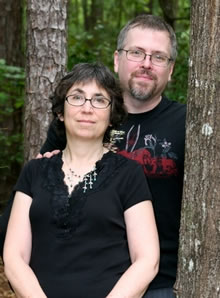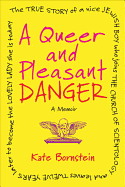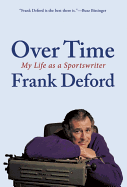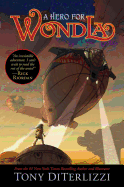 Editor and publisher Ann VanderMeer and her husband, editor and author Jeff VanderMeer, are the editors of The Weird: A Compendium of Strange and Dark Stories, a 1,152-page, almost four-pound book just published by Tor.
Editor and publisher Ann VanderMeer and her husband, editor and author Jeff VanderMeer, are the editors of The Weird: A Compendium of Strange and Dark Stories, a 1,152-page, almost four-pound book just published by Tor.
Tell us a little about who you are.
Ann: I started out my editing career as a reader. I grew up with all the Wizard of Oz books, which is its own kind of weirdness, and I've always tended to love that type of fiction. Back in the late '80s, I became the publisher/editor of my own magazine, The Silver Web, and about six years ago I was asked to step in and be the fiction editor for Weird Tales, which is the oldest fantasy magazine in the world, started in 1923. My love of weird fiction has continued ever since.
Jeff: I started writing fiction when I was in my early teens and started editing literary and poetry magazines. The fiction I was writing became categorized as dark fantasy or weird fiction. But when I was writing it, I just thought of it as fiction! As both an editor and a writer, then, I went through all these works that, to me, fit together but they were divided in ways that I felt were artificial. Over time, my editing projects got more ambitious. I won a World Fantasy Award in 2003 for an anthology series called Leviathan. At the same time I had a book out called City of Saints and Madmen, which was picked up as part of the New Weird movement; I also had a story in it that won a World Fantasy Award. Things just kind of snowballed from there.
We started editing anthologies in 2007 because we wanted to join forces there; it made more sense to do it that way.
Ann: We've done a lot of anthologies together, some of them reprint anthologies and some original fiction anthologies. We edited an anthology of pirate stories called Fast Ships, Black Sails, and we did an anthology called Steampunk, and of course this current monstrosity.
What is "weird fiction"?
Jeff: We basically found two strands of "the weird." One is the one most people think of when they think of the weird tale, the one defined by H.P. Lovecraft: a story that has a supernatural element but doesn't fall into the category of a traditional ghost story or gothic tale, or--especially in the modern age--a tale that doesn't include vampires or werewolves and zombies, because they have become so archetypal that they are fully defined, they no longer represent the unknown.
The other strand we found was Kafka-esque weird. The difference here being that in the first type, the character comes into contact with the weird or whatever supernatural elements. With Kafka, you're already in the weird, you're living it.
Ann: A short answer can be "when the strange unusual supernatural and bizarre invade into your normal daily life, with the unknown and in many cases the unknowable."
Jeff: There's also a sort of beauty and discovery mixed in with the horror, which can produce an ecstatic or transformative moment. These tales may include something that's scary or very disturbing, but the point isn't usually the scare itself.
What stories can readers look forward to in this anthology that piqued your own personal interest in the weird?
Jeff: We actually published several of them in this book, since many of these have been out of print for over 40 years. For example, Jean Ray's "The Shadowy Street" and "The Mainz Psalter," which is a major achievement, since he needs to be reclaimed, as he's considered in France to be the equal or better than Lovecraft.
It's so excruciating to pick, since there's so many favorites in here. People don't know Ben Okri writes some amazing supernatural short stories. People don't know Amos Tutuola, who wrote The Palm-Wine Drinkard. There's an amazing excerpt from that book in our anthology, a phantasmagorical piece that's like nothing I've ever read before. I love the story by Clive Barker, and then there's "The Brotherhood of Mutilation" by Brian Evenson, who is one of America's best writers of weird fiction. There's an amazing Kafka-esque story in there by Leena Krohn called "Tainaron: Mail from Another City," which is just one of the most amazing things I've read.
Ann: People think of Leonora Carrington as being a surreal artist, but they don't realize that she was also a writer as well; we've got one of her stories in there from the early '40s.
I grew up as a huge Twilight Zone fan, and there was this one episode called "It's a Good Life." It was my favorite, even though it scared me, and I loved it so much. Growing up, you don't realize that someone also had to write it. As Jeff and I were combing through stories for this book, I came across the original story written by Jerome Bixby. I was really surprised by how much that story creeped me out--the way this writer was able to convey this feeling really impressed me, even as a fan of the TV episode.
 As big as the book is (110 stories) and as many stories are included within, how many aren't included that should be?
As big as the book is (110 stories) and as many stories are included within, how many aren't included that should be?
Jeff: There are a few things we couldn't get permission for. At one point for one story, we were having to educate monks in a monastery who owned the e-book rights about what the Internet was. In another case, we were told that the person who represented the estate was in a coma and that there was no provision for the rights; she would have to pass away or come out of the coma for us to work out the rights to the story. We even had a plan to involve a friend of ours who was in a Mexican circus. Our friend had a horse, and was going to ride down the coast of Mexico to secure the rights to a story. Luckily, the author's agent came through at the last second. Multiply this by 116 stories by authors who are fairly obscure, and you get a sense of how complicated the rights issues were for this book.
Ultimately, the stories like this were few, and considering the amount of stories we could include, we're very happy with the result.
Ann: We started a website called Weird Fiction Review where we're publishing some additional fiction and nonfiction, essays and book reviews and movie reviews and all kinds of things related to the weird. That was our way of expanding the book, so to speak.
What's next for you both?
Ann: I'm just finishing up Steampunk Revolution, a reprint anthology with a handful of original fiction in it that I'm really excited about. I'm also hoping to do an anthology for the 90-year anniversary of Weird Tales.
Jeff: I'm working on a book for September called Wonderbook: The Definitive Illustrated Guide to Creative Writing. It's about finding a new visual language for teaching creative writing--plot structures, diagrams, things that deal with the texture of fiction presented in an illustrated, artistic way.
I've also just finished another novel, and a couple more coming down the pike, now that I have some time. Doing a lot of short fiction and nonfiction as well.
Ann: We're also doing a couple of anthologies that we can't talk about yet.
Jeff: We'd like to do a big anthology on dark fantasy...
Ann: ...because we're insane. --Rob LeFebvre, freelance writer and editor
Ann and Jeff VandeMeer: Partners in Weird



 Editor and publisher Ann VanderMeer and her husband, editor and author
Editor and publisher Ann VanderMeer and her husband, editor and author  As big as the book is (110 stories) and as many stories are included within, how many aren't included that should be?
As big as the book is (110 stories) and as many stories are included within, how many aren't included that should be? Andrew Fukuda
Andrew Fukuda Book you've bought for the cover:
Book you've bought for the cover: When people ask me to name books that have changed my life, Pilgrim at Tinker Creek is always first on my list. I read it in my early 20s, before anyone knew who Annie Dillard was. Then she won the Pulitzer Prize and everyone knew her, but I never shook the feeling that she spoke to me first.
When people ask me to name books that have changed my life, Pilgrim at Tinker Creek is always first on my list. I read it in my early 20s, before anyone knew who Annie Dillard was. Then she won the Pulitzer Prize and everyone knew her, but I never shook the feeling that she spoke to me first.











